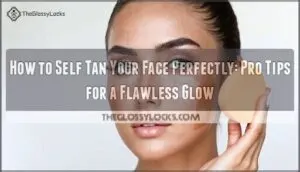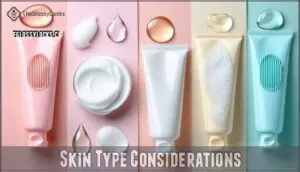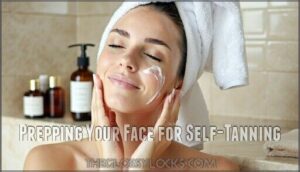This site is supported by our readers. We may earn a commission, at no cost to you, if you purchase through links.

First, cleanse and gently exfoliate your skin, then apply a light moisturizer to dry areas like your hairline and eyebrows.
Use a makeup sponge or clean hands to apply the tanner in small amounts, working from the center of your face outward, and blend carefully around your jawline and ears—these spots love to go rogue and turn orange.
Let it develop for the recommended time, usually 4-6 hours, and remember that the secret lies in proper preparation and patience, plus knowing exactly which application mistakes can turn your glow into a disaster, and understanding the importance of complete concepts.
Table Of Contents
- Key Takeaways
- How to Self Tan Your Face Perfectly?
- Understanding Self-Tanning for The Face
- Choosing The Right Self-Tanner
- Prepping Your Face for Self-Tanning
- Applying Self-Tanner to Your Face
- Contouring With Self-Tanner
- Avoiding Common Self-Tanning Mistakes
- Maintaining Your Facial Self-Tan
- Removing Self-Tanner From Your Face
- Natural Alternatives for Facial Tanning
- Safety Precautions and Skin Health
- Frequently Asked Questions (FAQs)
- How to tan your face naturally?
- Should you self tan your face?
- How to get a flawless self tan?
- How to fake tan your face properly?
- How do I get a Good Tan?
- How do I use self tanning?
- How do you get the perfect tan on your face?
- How do you apply self tan to your face?
- Why does fake tan never stay on my face?
- How do you get the perfect fake tan on your face?
- Conclusion
Key Takeaways
- Choose the right product for your face – You’ll need a facial-specific self-tanner that’s one shade lighter than your desired result, and if you’ve got oily or acne-prone skin, stick to non-comedogenic formulas to prevent breakouts.
- Prep your skin properly before application – You must cleanse, gently exfoliate, and apply a light moisturizer to dry areas like your hairline and eyebrows, as proper preparation prevents streaks and ensures even color development.
- Apply with precision and blend carefully – You should use a makeup sponge or clean hands to apply small amounts in circular motions, working from your face’s center outward while paying special attention to blending around your jawline, ears, and hairline, where mistakes show most.
- Be patient and maintain your tan – You’ll get the best results by letting the tanner develop for 4-6 hours without touching your face, then maintain your glow with daily moisturizing and gentle touch-ups every few days using gradual tanners or tanning drops.
How to Self Tan Your Face Perfectly?
If you’re wondering how to fake tan your face flawlessly, here’s how.
Start by choosing a self-tanner suited to your skin type—opt for non-comedogenic options if you have sensitive skin.
Always cleanse, exfoliate, and lightly moisturize before application, targeting dry zones like your nose or forehead.
Use application tools like a tanning mitt or brush for streak-free face tan results.
Dab the product evenly in circular motions, avoiding heavy pressure.
Don’t skip blending near your hairline, neck, and ears—it’s key for a natural look.
Product layering works well for those seeking deeper tones but start light.
For a safer option, consider using a product with naturally derived DHA.
For long-lasting tan longevity, allow the product to dry for 15 minutes and avoid touching your face.
Enjoy your radiant glow!
Understanding Self-Tanning for The Face
Facial skin is thinner, more sensitive, and has different oil levels than the body, so treating it right during self-tanning is important. A self tan face routine starts with understanding tanner ingredients. DHA and Erythrulose are commonly used, gradually producing a natural glow without UV damage.
Facial skin deserves special care—it’s more delicate than your body, so choose your self-tanner wisely for that perfect glow.
Gradual tan benefits include control over color intensity and fewer streaks. However, patch testing is key—this checks for allergies or uneven absorption. Be cautious about sunless tanning risks. Poor application or ignoring face tanning tips can lead to patchy results**.
When learning how to fake tan face effectively:
- Use a non-comedogenic formula for an even tan face.
- Avoid body tanners; they’re heavier on delicate facial skin.
- Always prep properly before face tan application.
Patience leads to perfection! Many users prefer self tanning drops for customizable color.
Choosing The Right Self-Tanner
Finding the right self-tanner for your face means considering your skin type, undertones, and personal preferences. Choose a product specifically designed for facial use to avoid clogged pores or irritation.
Skin Type Considerations

When choosing the right facial self-tanner, your skin type matters.
If you’ve got oily or acne-prone skin, stick to noncomedogenic formulas to avoid clogged pores. For dry skin, hydrating tanners can prevent accentuating skin dryness.
Sensitive skin? Go fragrance-free to avoid irritation. Combination skin benefits from balanced, lightweight options.
Pre-tan preparation is also essential for a flawless tan.
Always tailor your choice to what works for your face, ensuring a flawless glow that feels as good as it looks!
Shade Selection

Picking the right shade matters! Match your skin tone and undertones for a glow that looks natural. Stay subtle by choosing one shade darker than your complexion—less is more here.
- Undertone Matching: Warm, cool, or neutral—know yours! Understanding your face tan undertones is essential for a natural look.
- Gradual Application: It’s easier to reapply.
- Initial Lightness: Start soft; build color over time.
- Reapplication Timing: Deepen as needed, avoiding blotches.
Formulation Types

Choosing the right face tanner formulation isn’t one-size-fits-all.
Each type caters to unique skin needs:
- Mousses: Lightweight, fast-drying, and streak-free—perfect for oily skin.
- Drops: Customizable tanning drops for face; mix into moisturizer for control.
- Creams: Hydrating, soothing cream benefits ideal for dry skin.
- Mists: Simple self-tanning mist application for quick, even coverage.
- Gels: Lightweight, noncomedogenic gel properties, great for acne-prone skin.
Pair formulation with your skin type for flawless results.
Prepping Your Face for Self-Tanning

To get a smooth, even tan on your face, start by preparing your skin properly.
Cleanse, exfoliate, and moisturize to create a flawless base for the self-tanner to work its magic.
Cleansing
Before applying self-tanner, a pre-tan cleanse is essential for flawless results.
Start by removing all makeup using micellar water, which gently lifts dirt without leaving residue.
Next, use a mild, pH-balanced cleanser suited for facial skin care to help oil removal without stripping the skin.
Consider double cleansing if you wear heavy makeup or sunscreen.
Exfoliating
Exfoliating is key to getting an even, streak-free tan.
Use a gentle exfoliator—like a chemical one with lactic acid or a mild physical scrub—2-3 times a week.
Focus on sloughing off dead skin, as an exfoliated face absorbs products better. If you’ve got sensitive skin, stick to milder options to avoid irritation.
Don’t overdo it; irritated skin can ruin your tan. After exfoliation, make certain your skin feels smooth and clean to prep it perfectly for tanning.
Many people purchase a lactic acid exfoliator for their skincare routine.
Moisturizing
Don’t skip moisturizing after exfoliating—hydration is key! Use an oil-free moisturizer to avoid disrupting your self-tanner’s absorption.
Focus on typically dry areas like your cheeks, forehead, and around the nose, but don’t overdo it. Over-moisturizing can create uneven spots.
Skin hydration guarantees a smooth, flawless tan application. Pro tip: Dust a bit of translucent powder over your moisturized face to lock it in, minimize smudging, and keep your skin prepped for post-tan hydration magic while you sleep.
Applying Self-Tanner to Your Face
Applying self-tanner to your face requires careful technique to guarantee an even, streak-free finish. By focusing on light, circular motions and proper blending, you can achieve a natural, sun-kissed glow.
Application Techniques
Once your skin’s ready, focus on smooth self-tanner application.
Use mitts or hands in circular motions to blend the product evenly. For extra precision, a makeup brush works wonders.
Apply gently, paying attention to your hairline and jawline to avoid harsh edges. Let the tanner dry fully before moving.
Setting it with translucent powder helps prevent streaks!
Coverage Areas
Don’t skip these face tanning coverage areas for a seamless glow.
- Ears and Neck: Blend tanner behind ears, along the jawline, and down the neck.
- Hairline Blending: Lightly buff product around your hairline for an undetectable finish.
- Under Eyes and Lip Area: Use a minimal amount under the eyes and around lips to avoid harsh lines.
Blending Tips
Blending self-tanner is the key to a seamless application and streakfree face tan.
Use brush techniques in circular motions, focusing on areas like hairline and jawline.
For a natural finish, start light, layer gradually, and consider product dilution.
Avoiding streaks requires patience—blend outward evenly.
Check tan before after blending to spot any face tan mistakes early, ensuring perfection.
Contouring With Self-Tanner
Contouring with self-tanner lets you subtly enhance your natural features while achieving a sun-kissed look.
By applying tanner to specific areas, you can create dimension and bring balance to your face, which is a key part of the contouring process to subtly enhance your natural features.
Enhancing Facial Features
Highlight your natural features with precise self-tanner application for a sculpted look.
Start by Highlighting Cheekbones—apply a touch of tanner to the tops for a sun-kissed glow.
Enhance your Brow Definition with subtle blending near the arches.
For a Slimming Nose, swipe a thin line of tanner along the sides and blend smoothly.
Define your jawline by applying a slightly darker shade under the chin and along the jawline’s edge.
Remember to exfoliate before tanning for even application.
Always focus on blending well to guarantee a flawless, seamless complexion.
Creating Dimension
Creating dimension with facial self-tanning is your ticket to a naturally sculpted look. By defining depth and shadow placement, you can achieve a subtle, yet polished contour.
Here’s how to contour effectively using self-tanner:
- Apply a slightly darker shade to hollows of your cheeks, jawline, and temples.
- Focus on blending techniques using a tanning mitt or brush for seamless results.
- Use minimal product to control contour intensity and avoid harsh lines.
- Incorporate highlight placement with your regular tanner for balance.
With proper shade selection and blending, this long-lasting trick enhances your features naturally.
Avoiding Common Self-Tanning Mistakes

Skipping exfoliation or applying too much self-tanner is a fast track to uneven streaks, patchy color, or the dreaded orange face. Always start with clean, exfoliated skin to avoid dark spots and a patchy tan.
Skip the prep, get the pumpkin face—exfoliation isn’t optional when you’re chasing that perfect glow.
Missed a spot? That’s where uneven application and streaks show up most. Be mindful—using too much product around areas like the nose or chin can also lead to an unnatural look.
Thin out the tanner with a little moisturizer for tricky areas, like the edges of your face, to avoid harsh lines. Jumping in with a heavy hand only increases the risk of streaks.
Forgetting to blend product near your hairline or jawline can result in noticeable differences, so use small circular motions and a light touch to achieve a more natural appearance and avoid harsh lines.
Maintaining Your Facial Self-Tan
Keeping your facial self-tan looking flawless requires daily care and a few adjustments to your routine.
By moisturizing regularly and protecting your skin from water and friction, you can extend the glow and avoid premature fading.
Longevity Tips
In terms of maintaining your facial self-tan, small changes make a big difference.
Facial skin sheds faster, so focus on these steps for a lasting glow:
- Hydration Importance: Apply moisturizer daily to prevent flaking and keep your tan intact.
- Gentle Exfoliation: Lightly exfoliate every few days to avoid patchiness without stripping the tan.
- Gradual Reapplication: Use a gradual tanner to touch up fading areas evenly.
- Sunscreen Use: Protect your skin and tan by using SPF daily.
Consistency in your skin care routine is key to prolonging tanning duration!
Touch-Up Techniques
Touching up your facial self-tan is all about keeping the glow while avoiding streaks or patchy areas that can come with uneven fading.
Keep your tan maintenance simple yet effective.
- Use blending tools like makeup sponges to perfect any color correction or patch repair.
- Opt for gradual application with tanners or tanning drops for a natural finish.
- Mix tanner with moisturizer for an even tone and longer tanning duration.
- Gently exfoliate any patchy areas before each reapply to restore smoothness.
For tan extending, apply a light layer every few days to maintain vibrancy while avoiding heavy buildup.
Less is more—your touch-ups should feel effortless, leaving your skin looking refreshed and glowing without overdoing it!
Removing Self-Tanner From Your Face
The trickiest part of self-tanning? Getting rid of mistakes without looking like you wrestled with a pumpkin.
Oil cleansing works wonders for gentle removal, while lemon juice mixed with baking soda tackles stubborn orange patches through natural exfoliation.
For tan correction, try micellar water or baby oil – let it sit before rinsing. Toner use helps balance your skin afterward.
Regular skin exfoliation prevents uneven fading, but go easy on your face. Remember, patience beats scrubbing in the process of tan maintenance.
Since facial skin is delicate, consider using gentle massage techniques for removal.
Natural Alternatives for Facial Tanning
Exploring natural alternatives opens up a world of gentle, chemical-free facial tanning options.
These plant-based tanning methods harness ingredients you likely already have at home, making DIY bronzers both accessible and affordable.
Popular natural alternatives include:
- Coconut oil and carrot juice: Mix equal parts for a nourishing sunless oil that gradually builds color
- Black tea and aloe vera gel: Brew strong tea, cool completely, then blend with aloe for a hydrating herbal infusion
- Honey and papaya masks: Create food-based tans by mashing ripe papaya with honey for natural enzymes that enhance your glow
These natural alternatives work slower than commercial products but offer gentler results.
As a bonus, many users find that natural ingredients offer benefits to the skin.
Apply consistently over several days to build your desired shade.
Always patch-test first, as natural doesn’t automatically mean non-irritating for sensitive skin.
Safety Precautions and Skin Health
While natural DHA alternatives offer gentler options, protecting your skin remains paramount when self-tanning your face.
Always perform a patch test on your inner wrist 24 hours before applying any new product to check for allergic reactions or skin irritation.
Pay attention to product ingredients—choose noncomedogenic formulas if you’re acne-prone.
Your skin sensitivity matters more than achieving the perfect glow.
If you experience any irritation, stop using the product immediately.
Don’t overdo applications thinking more equals better results—moderation prevents skin damage.
Remember sunscreen importance: even with a fake tan, you’ll need SPF 30 or higher daily.
Self-tanners don’t provide UV protection.
Think of irritation prevention as your skin’s insurance policy.
Listen to what your skin tells you, and you’ll maintain that healthy radiance long-term.
Frequently Asked Questions (FAQs)
How to tan your face naturally?
Like those ancient sun-worshippers, you can achieve natural facial tanning through gradual sun exposure with SPF protection.
Eating beta-carotene rich foods like carrots, or using gentle self-tanners mixed with moisturizer for safer results.
Should you self tan your face?
Yes, you should self-tan your face if you want even color matching your body.
Face-specific formulas prevent breakouts and streaking, they’re gentler than body tanners and fade naturally with your skin’s faster cell turnover, which helps in achieving a more natural look.
How to get a flawless self tan?
Exfoliate and cleanse your skin first, then apply self-tanner in circular motions using a mitt or brush.
Blend carefully around hairline and jawline.
Wait eight hours before showering for perfect development.
How to fake tan your face properly?
About 73% of people mess up facial self-tanning by skipping prep work.
You’ll need to exfoliate gently, apply with circular motions using a mitt, blend carefully around your hairline.
Let it develop overnight for natural-looking results.
How do I get a Good Tan?
Start by exfoliating your skin 24 hours beforehand, then choose a quality self-tanner that matches your skin tone.
Apply evenly with circular motions, blend carefully around joints.
Moisturize daily to maintain your gorgeous glow.
How do I use self tanning?
Don’t worry about looking orange—modern self-tanners won’t betray you. Exfoliate first, apply with circular motions using gloves, blend around joints, and wait eight hours before showering for natural-looking results.
How do you get the perfect tan on your face?
Choose face-specific tanner, exfoliate 24 hours prior, apply with clean hands using circular motions, blend into hairline and neck, avoid water for 8 hours, and moisturize daily to maintain your glow.
How do you apply self tan to your face?
Transform your complexion like a pro artist!
Start with clean, dry skin, then apply facial self-tanner in small circular motions using fingertips.
Blend thoroughly around hairline, ears, and jawline for seamless results.
Why does fake tan never stay on my face?
Your face sheds skin cells faster than your body, causing fake tan to fade quickly. You’re also washing, touching, and using skincare products that strip the color away daily.
How do you get the perfect fake tan on your face?
Start with clean, exfoliated skin and apply a face-specific self-tanner using circular motions. Blend carefully around your hairline and jawline, then let it develop overnight without touching or getting wet.
Conclusion
Ironically, achieving the perfect sun-kissed glow requires avoiding actual sun exposure entirely.
Mastering how to self tan your face perfectly comes down to patience, preparation, and practice.
You’ll make mistakes initially—everyone does—but each application teaches you something new about your skin’s unique needs.
Remember to start light, blend thoroughly, and maintain your tan with regular touch-ups.
With these techniques, you’ll develop the confidence to create a natural-looking glow that enhances your features year-round.
- https://www.instagram.com/julesvonhep/
- https://theisleofparadise.com/
- https://www.byrdie.com/dihydroxyacetone-for-skin-5194916
- https://bondisands.com/blogs/tips-and-tricks/how-to-choose-the-perfect-self-tan-shade-for-your-skin-tone?srsltid=AfmBOopoLsyxoWBapgopMcIMJL8eP4VbFk9rByo_1kavinrWZa2Oa8dv
- https://www.lorealparisusa.com/beauty-magazine/skin-care/sun-care-and-self-tanning/fitzpatrick-skin-type












